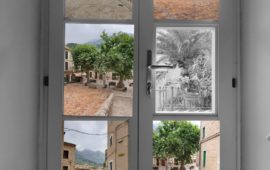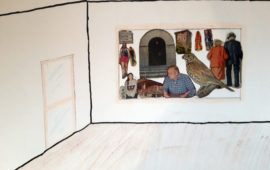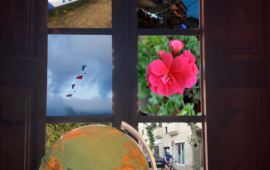Beyond the window: which world do we rediscover?
Activity inspired by Martha Rosler’s work “House Beautiful. Bringing the War Home”
Artist biography
Martha Rosler (New York) uses a variety of media in her work, such as video, photography, photomontage, sculpture, installation and performance. She is also a critic, theorist, and a professor of fine arts. Rosler’s work is centered on the role of women in society, as represented in the media and advertising, as well as the relationship between private life and the public sphere. Rosler interrogates the world we live in from a feminist and critical perspective. Her political commitment has led her to deal with the conflicts and problems that take place not only in her country but also internationally, in places such as Cuba, Mexico, the former Yugoslavia, or nearer ones to us, such as Barcelona.
Artwork explanation
Martha Rosler addresses political and social issues in the world we live in. Rosler made the series of photomontages or collages entitled “House Beautiful. Bringing the war home”, from approximately 1967 to 1972, during the Vietnam War. In these photomontages, the artist superimposes war images from Life Magazine onto clippings of idealized homes, revealing the extent to which the collective experience of war can be shaped by media images. These photomontages were photocopied and distributed during protests against the war, because Rosler’s intent was to aid the opposition to the war.
Years later, during the wars in Iraq and Afghanistan, Rosler returned to this photomontage series: “House Beautiful. Bringing the war home. New series”, (2004 – 2008), in which we find the photomontage “Point and Shoot” (2008), currently on display at the museum, in the exhibition “Martha Rosler. How do we get there from here?” Martha Rosler made this collage by combining several magazine clippings on a single sheet of paper. In this way, the artist contrasts a glamorous image of a model with a more disturbing image that shows the reality of war, in order to question the imaginary division of society between “Here” (our homes) and “There” (external conflicts) and continues to protest against the unequal wars fought by her country.
In Rosler’s comfortable houses – supposedly safe and away from the world conflicts – windows always stand out, because they are the elements of the home that hinge on the outside world and symbolically connect us with what we often ignore and don’t let it affect us. The artist asks for solidarity with these other realities outside our immediate environment that we usually feel so far from us, for one of her main messages is that we are inevitably tied to those joint realities. To see Rosler’s artworks mentioned here and some other collages not exhibited in the museum, please consult the PDF atached.
How to participate
We encourage you to make a collage inspired by the work of Martha Rosler.
Martha Rosler uses collage as a critical tool with which she brings the conflicts of the world closer to home, to remind us of our connections to them. A collage is an art technique that involves clipping different materials, such as photographs, magazines, newspapers, and everyday objects on a piece of paper to create a composition.
We have been in quarantine for many days and at last children are allowed to leave the house, although with many limitations (going out with just one adult, no further than 1 km from home and no longer than an hour a day). Surely these first outings have been marked by the strangeness of rediscovering spaces and familiar places that we can’t live in the same way as we have done so far. What has changed? We would like to propose to you to activate your critical and reflective spirit, that so characterises Martha Rosler’s work, and that you share with us how you perceive the outside world when you go out these days. We would also like, as the artist does in many of her collages, that you bring this outside world, that had been so far away from us and now we can rediscover, closer to home through the window.
- Choose a room in your home that has a window. Take a picture of it and print it. If you don’t have a printer don’t worry, you can make a detailed drawing of the window.
- Reflect as a family on how you have experienced these first outings. What surprises you when you are out on the street? Are these transformations of the streets and the public spaces changes, positive or negative, with respect to how you remember the city before the lockdown? What is it that you dislike about the new situation when you’re in the street? What do you miss? What would you change?
- Gather different images separately for each of the themes you’d like to share and present in your collage. You could make drawings or take advantage of your outings to take photographs. You could also look for magazines, brochures, and miscellaneous papers that you have at home and use the cut-outs or bits that help you create your composition.
- Ready to start the collage? Get the print or drawing of your window frame ready, then make a composition with all the images you have prepared from your outings and the cut outs you have selected, then glue it inside the window space. Notice how Martha Rosler does it on the PDF attached.
- Have you finished the collage? Take a picture of it or scan it. Send it to us at noufuturdesdecasa@esbaluard.org
- We will collect all your contributions and publish them through our website and the museum’s social networks.
Results















